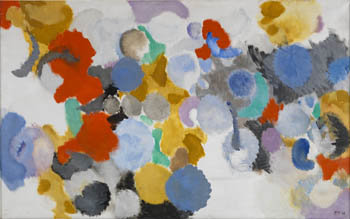Le Grand Geste!
dal 8/4/2010 al 31/7/2010
Segnalato da
Ernst Wilhelm
Emil Schumacher
Helen Frankenthaler
Mark Tobey
Jean Fautrier
Jackson Pollock
Kay Heymer
Susanne Rennert
8/4/2010
Le Grand Geste!
Museum Kunstpalast, Dusseldorf
The exhibition concentrates on the period between 1946 and 1964, focussing on the climaxes of the German Informel movement until Pop Art began to dominate the international art scene and largely superseded abstract expressionist tendencies. The existential ambition of this gestural, abstract expressionist form of painting becomes evident and manifests itself not least in the large-scale formats of many principal works of this art movement. On display 150 paintings - a path leading from France and the USA to Germany, Italy, The Netherlands, Spain and other European countries.

Curated by Kay Heymer and Susanne Rennert
The 1959 documenta II in Kassel marked a peak in gestural abstract painting. Here, fourteen years after the end of World War II a central tendency of painting was celebrated, which presented itself as an international phenomenon spanning the entire Western world. Following this documenta and a major tour of American Abstract Expressionism to several European capitals in the preceding year, the so-called genre of informal painting received, in a sense, official status. The significance of ‘abstraction as a world language’ had asserted and established itself, even though new developments, for instance a tendency towards intermediality, had begun to emerge.
50 years later, the exhibition Le grand geste! at museum kunst palast in Düsseldorf shows around 150 paintings retracing the path and artistic development of Art Informel and Abstract Expressionism – a path leading from France and the USA to Germany, Italy, The Netherlands, Spain and other European countries.
The artistic avant-garde after 1945 – disjointed and disillusioned, but also highly motivated by moral and existential issues – was in search of forms of expression which were not corrupted by the recent events of the world war and which endowed creative processes with the greatest possible freedom.
The young artists, partly drawing from pictorial practices of Surrealism, experimented with new materials and processes which enormously extended the conceptual spectrum: colour was poured and trickled, grounds were scratched, or the painting process was accelerated to the extreme. Canvasses lying on the floor turned into stages for the artist. Such developments already heralded a transition to Action Art, as the term ‘Action Painting’ – coined by Harold Rosenberg and referring to gestural painting in the USA – suggests.
The European equivalent of this art form was ascribed a variety of terms, such as Lyrical Abstraction, Tachisme, or Art Informel, the latter of which, introduced in 1950 by the French critic Michel Tapié, turned out to be the most durable. Similar to an informal picture, this artistic movement itself may be described as a variable, open structure – it is thus less a style than an artistic attitude. Karl Otto Götz, one of the movement’s most important German protagonists, described Art Informel as ‘the dissolution of the traditional formal principle, making use of diverse possibilities in terms of technique and material.’ Accordingly, important structural foundations were laid for subsequent generations of artists.
The Düsseldorf exhibition Le grand geste! concentrates on the period between 1946 and 1964, focussing on the climaxes of the German Informel movement until Pop Art began to dominate the international art scene and largely superseded abstract expressionist tendencies. The existential ambition of this gestural, abstract expressionist form of painting becomes evident and manifests itself not least in the large-scale formats of many principal works of this art movement.
The Düsseldorf show, which presents a wealth of important works from US-American and European public and private collections, has an international outlook, placing particular emphasis on France (focussing on Paris), on the USA (especially New York) and Germany.
A comprehensive accompanying programme, including lectures, a two-day symposium in collaboration with the Düsseldorf Academy of Art, as well as a Jazz concert with Bobby Few, will complement the exhibition.
There will be a richly illustrated catalogue comprising approx. 320 pages, published by DuMont, which will include a foreword by Beat Wismer, texts by Kay Heymer and Dr. Susanne Rennert, as well as artist interviews and a wealth of source texts.
Lenders:
Berkeley Art Museum and Pacific Film Archive, Kalifornien
Emil Schumacher Stiftung, Hagen
K20, Düsseldorf
Kunststiftung Hann Trier, Mechernich
Langen Foundation, Neuss
LVR-Landesmuseum, Bonn
Museum Ludwig, Köln
Museum Wiesbaden
Nachlass Prof. Peter Brüning, Ratingen
Sammlung Sander, Darmstadt
Tate, London
The Menil Collection, Houston
The Museum of Modern Art, New York
Whitney Museum of American Art, New York
sowie weiteren privaten Sammlungen u.a.
Principal sponsor: E.ON AG
Supporter: WALL AG
Image: Nay, Ernst Wilhelm, Stunde Ypsilon, 1956
Öil auf Leinwand, 125 x 200 cm museum kunst palast, Düsseldorf, Sammlung Moderne Kunst, Foto: Achim Kukulies © E. Nay-Scheibler, Köln
Press contact:
Marina Schuster – Head of Communications / Press Officer, Tel: +49 (0) 211-89 962 11, email: marina.schuster@smkp.de
Christina Bolius - Press Work and Public Relations / Internet, Tel.: +49 (0) 211-89 962 50, email: christina.bolius@smkp.de
Opening 9th april 2010, 7pm
Stiftung museum kunst palast
Ehrenhof 4-5 - 40479 Dusseldorf
Opening hours
Monday–Sunday from 11 am to 6 pm
Thursday 11 am to 9 pm
Entrance fee
9,00 Euro / 7,00 Euro



